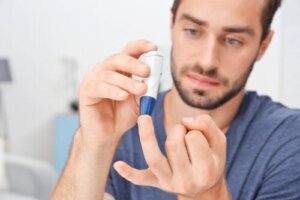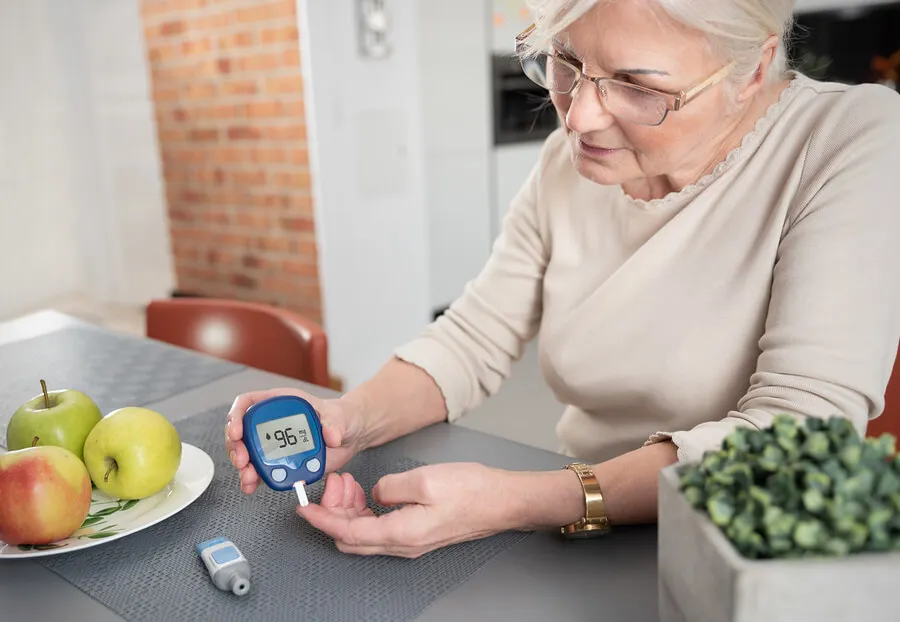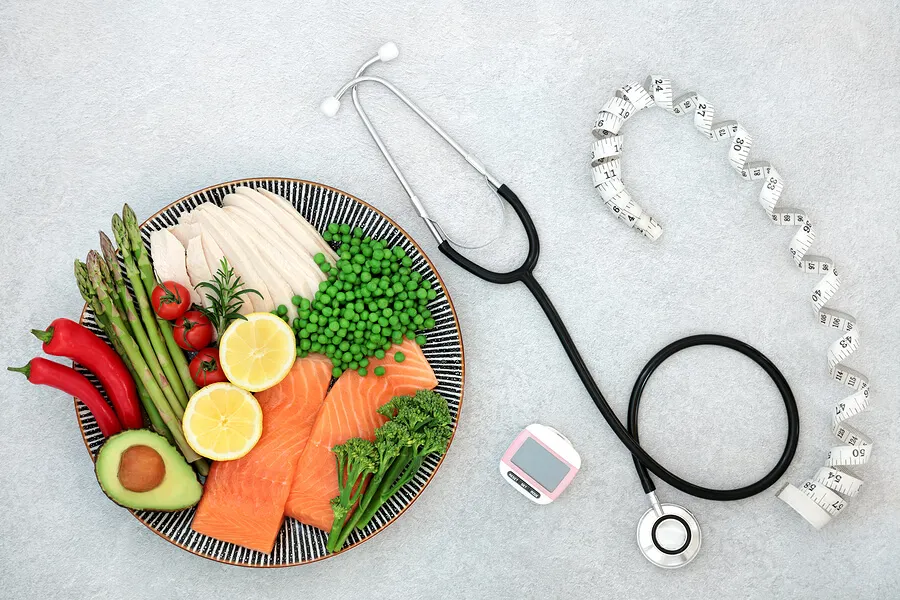How to Lower Blood Sugar Levels During an Emergency


Reviewed and approved by the nurse Leidy Mora Molina
High blood sugar levels, or hyperglycemia, occur when the body cannot effectively move sugar from the blood into the cells. Generally speaking, this is due to a shortage of insulin. We’ll look at how to lower blood sugar levels in this article.
High blood sugar is when you reach 124 milligrams of glucose per deciliter of blood not having eaten. If food has been eaten, the figure shouldn’t be higher than 180 milligrams of glucose per deciliter of blood.
High blood sugar levels put a person’s health at risk. Such episodes occur especially in people with type 1 and type 2 diabetes. The basic approach is to administer insulin.
Causes of high blood sugar
In general, several factors contribute to elevated blood sugar, or hyperglycemia. Diets with poor carbohydrate control and sedentary lifestyles are the main culprits. Other common causes of hyperglycemia include the following:
- Not using the correct dose of insulin.
- Forgetting to use oral hypoglycemic drugs, such as metformin.
- Having a respiratory, urinary, or gastrointestinal infection.
- Physical trauma.
- Pregnancy.
- Drug use, such as cocaine.
How to identify a diabetes emergency

Whatever the cause of high blood sugar levels, it’s important to know the symptoms in order to know how to act. These symptoms are usually as follows:
- Excessive increase in thirst
- A need to urinate more frequently
- Cold sweats
- Blurred vision
- Weakness and lethargy
- Numbness
- Palpitations
- Headaches
- Nausea and vomiting
- Shortness of breath
- Stomach pain
- Ketones in the urine – these are detected with a urine test strip.
It’s very important to act quickly when high blood sugar levels are detected. If the situation evolves, there’s a risk of developing a diabetic coma or ketoacidosis. This occurs when there isn’t enough insulin and it constitutes a medical emergency.
Other complications such as diabetic neuropathy, diabetic retinopathy, kidney or heart problems, and hyperglycemic hyperosmolar syndrome (HHS) can also occur.
Read more here: Medications that Can Increase Blood Sugar
How to control blood sugar levels quickly
High blood sugar levels should be addressed promptly to stabilize the body. The emergency measures are threefold: administer insulin, drink water, and exercise.
Administer insulin
Insulin administration is the basic measure to take when there are high blood sugar levels in people who have type 1 or 2 diabetes. This is even more important when there are more than 250 milligrams of glucose per deciliter of blood, as the condition can easily progress to a diabetic coma.
The first thing, then, is to measure the level of sugar in the blood. If it’s very high, the best thing to do is to go to a medical center. If it’s high, but not extremely high, the best thing to do is to apply a dose of insulin to correct the problem.
Studies estimate that the recommended insulin dose varies between 0.3 to 0.5 International Units (IU) per kilogram of weight. It’s individualized for each person and should cover basal and post-food intake needs.
It’s important to keep in mind that a significant improvement won’t be observed until two or three hours after taking the correction dose. Therefore, you should avoid taking a new dose before that time, as it could cause an abrupt drop in blood sugar levels.
Drinking water
One of the reasons for elevated blood sugar levels is dehydration. When you don’t drink enough water, some components of the blood, such as glucose, become more concentrated.
Therefore, it’s best to drink plenty of water, especially when you begin to feel unusually thirsty. This leads to more urine being produced, thus eliminating excess glucose in the blood and replenishing fluids in the bloodstream.
Exercise
Exercise is a very effective means of reducing high blood sugar levels. Even a 15-minute walk can have a significant impact on this condition. This is highly recommended for those who don’t take insulin.
If a person takes insulin and their blood sugar is very high, they shouldn’t exercise before a correction dose is administered. Otherwise, this could increase the level of ketones and have a negative effect.
Lifestyle and recommendations

The best way to prevent a rise in blood sugar is with a proper lifestyle. It’s best to observe the following recommendations:
- Regular exercise. Different studies indicate that exercise helps the body to make better use of the sugar that’s available in the bloodstream. This is known as increasing the body’s sensitivity to insulin.
- Regulating carbohydrate intake. The body converts carbohydrates into sugars, which is why a diet low in these foods should be maintained.
- Increase fiber intake. Fiber would help to decrease the absorption of sugar and the digestion of carbohydrates. The effect is a greater stabilization of glucose levels.
- Staying hydrated. Drinking water helps drain excess blood sugar through urine. It also prevents dehydration.
- Foods with a low glycemic index. These include beans, lentils, legumes, cereals, barley, corn, sweet potatoes, meat, eggs, seafood, non-starchy vegetables, and most fruits.
- Manage stress. High levels of stress hormones would also increase blood sugar levels. Relaxation techniques and exercise are good options.
- Sleep well. Poor quality sleep affects important metabolic hormones and this affects insulin sensitivity. It also influences weight gain.
- Foods rich in chromium and magnesium. These are micronutrients that help regulate blood sugar levels. They’re found in dark green leaves, avocados, beans, whole grains, dark chocolate, bananas, and fish.
- Apple cider vinegar and cinnamon. Apple cider vinegar and cinnamon have positive effects on the body, including helping to keep blood sugar levels stable.
- Avoid sugary drinks.
- Continuous monitoring. It’s important to monitor blood sugar levels frequently to detect any irregularities early.
Discover more here: Why Do People with Diabetes Experience Dry Mouth?
When to seek medical attention
People with diabetes should always be aware of blood glucose levels. In most cases, hyperglycemia doesn’t cause symptoms until it reaches very high levels. Some warning signs that require medical attention as soon as possible are the following:
- Nausea and vomiting
- Confusion and drowsiness
- Fast breathing
- Abdominal pain
Similarly, consult a specialist if your glycemia remains high throughout the day, despite having applied corrective measures. If you have strange symptoms, go to the doctor with a family member or friend who can keep an eye on your condition.
Keep blood sugar levels under control with the help of the doctor
If a person has diabetes or other problems with blood sugar levels, he/she should not change his/her diet or ingest new products without first consulting the doctor. Each case is different, and it’s best to be guided by your health care professional.
If your blood sugar levels rise relatively frequently, you should also consult your health care professional. It isn’t advisable to lower your blood sugar on a regular basis, as this instability also has negative consequences.
All cited sources were thoroughly reviewed by our team to ensure their quality, reliability, currency, and validity. The bibliography of this article was considered reliable and of academic or scientific accuracy.
- Chao, J. H., & Hirsch, I. B. (2015). Initial management of severe hyperglycemia in type 2 diabetes. En K. R. Feingold (Ed.), Endotext (pp. 1-9). MDText Inc. https://europepmc.org/article/nbk/nbk278997
- Cheisson, G., Jacqueminet, S., Cosson, E., Ichai, C., Leguerrier, A. M., Nicolescu-Catargi, B., … & Benhamou, D. (2018). Perioperative management of adult diabetic patients. Review of hyperglycaemia: definitions and pathophysiology. Anaesthesia Critical Care & Pain Medicine, 37(1), S5-S8. https://www.sciencedirect.com/science/article/pii/S235255681730293X
- Fayfman, M., Pasquel, F. J., & Umpierrez, G. E. (2017). Management of Hyperglycemic Crises: Diabetic Ketoacidosis and Hyperglycemic Hyperosmolar State. The Medical clinics of North America, 101(3), 587–606. https://pubmed.ncbi.nlm.nih.gov/28372715/
- French, E. K., Donihi, A. C., & Korytkowski, M. T. (2019). Diabetic ketoacidosis and hyperosmolar hyperglycemic syndrome: review of acute decompensated diabetes in adult patients. BMJ, 365(1114), 1-15. https://www.bmj.com/content/365/bmj.l1114.full
- The Global Diabetes Community. (15 de enero de 2019). Dehydration and Diabetes. https://www.diabetes.co.uk/dehydration-and-diabetes.html
- Goguen, J., Gilbert, J., & Diabetes Canada Clinical Practice Guidelines Expert Committee. (2018). Hyperglycemic emergencies in adults. Canadian Journal of Diabetes, 42(1), S109-S114. https://www.sciencedirect.com/science/article/pii/S1499267117308237
- Pasquel, F. J., & Umpierrez, G. E. (2014). Hyperosmolar hyperglycemic state: a historic review of the clinical presentation, diagnosis, and treatment. Diabetes Care, 37(11), 3124-3131. https://diabetesjournals.org/care/article-abstract/37/11/3124/29226
- Pérez Pérez, A., Conthe Gutiérrez, P., Aguilar Diosdado, M., Bertomeu Martínez, V., Galdos Anuncibay, P., García de Casasola, G., Gomis de Bárbara, R., Palma Gamiz, J. L., Puig Domingo, M., & Sánchez Rodríguez, Á. (2009). Tratamiento de la hiperglucemia en el hospital. Endocrinología y Nutrición, 56(6), 303–316. https://www.elsevier.es/es-revista-endocrinologia-nutricion-12-articulo-tratamiento-hiperglucemia-el-hospital-S157509220971945X
- Sánchez, M., Luna, M., Villarreal, Y., Zerpa, Y., & Bermúdez, Andrés. (2014). Manejo de la hiperglucemia en el paciente hospitalizado con diabetes mellitus. Revista Venezolana de Endocrinología y Metabolismo, 12(1), 34-40. https://ve.scielo.org/scielo.php?script=sci_arttext&pid=S1690-31102014000100005
- Sanz-Almazán, M., Montero-Carretero, T., Sánchez-Ramón, S., Jorge-Bravo, M. T., & Crespo-Soto, C. (2017). Estudio descriptivo de las complicaciones agudas diabéticas atendidas en un servicio de urgencias hospitalario. Emergencias: revista de la Sociedad Española de Medicina de Emergencias, 29(4), 245–248. https://medes.com/publication/123767
- Umpierrez, G. E., & Pasquel, F. J. (2017). Management of inpatient hyperglycemia and diabetes in older adults. Diabetes Care, 40(4), 509-517. https://diabetesjournals.org/care/article-abstract/40/4/509/3764
This text is provided for informational purposes only and does not replace consultation with a professional. If in doubt, consult your specialist.








